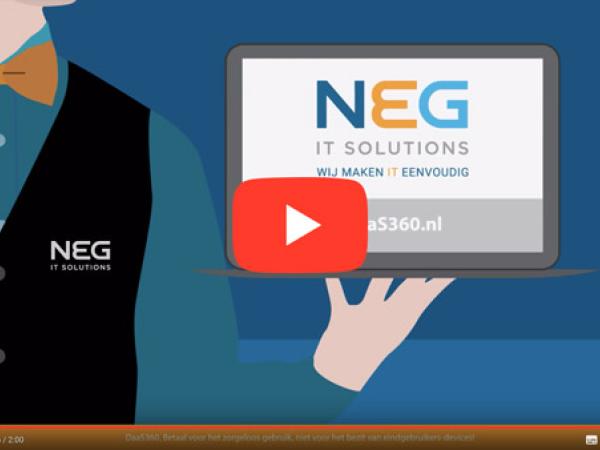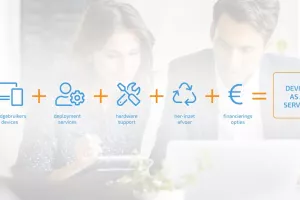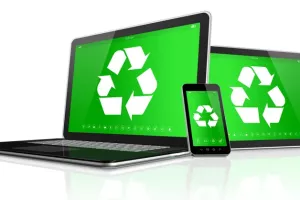Device as a Service
What is DaaS? What are the benefits of DaaS?
What is Device as a Service? (Hardware as a Service)
Device as a Service (DaaS for short) or Hardware as a Service (HaaS for short) is a service where you use a hardware device for a fixed price per month. This could be a laptop, tablet, smartphone or PC, for example.
In addition to the use of the device, the price also includes various services. Think of placement and installation, but also maintenance, repairs, replacement and disposal.
Device as a Service is therefore similar to leasing hardware. You only pay for the use of the device, not for ownership. At the end of the device's contract term, the vendor takes it back.
This is an attractive option for many companies. It offers more flexibility, making scaling up and down easier. In addition, the costs are lower compared to buying new hardware. In addition, it gives IT departments more time and space. They are less concerned with the day-to-day management of hardware and can therefore spend more time on relevant IT tasks.
Many organisations underestimate the amount of time involved in purchasing, implementing, managing and disposing of devices. Therefore, this hidden cost is often not or insufficiently considered in the business case on which they base their decisions.
Benefits of Device as a Service
DaaS, HaaS, PCaaS or lease?
Device as a Service (operational lease) |
|---|
You lease the hardware and it is not on your balance sheet |
Maintenance and management are arranged within the DaaS contract |
The monthly costs are deductible from the profit |
More economical than financial lease because of calculation costs |
Financial lease |
|---|
You are the owner after the term, the hardware is on your balance sheet |
You are responsible for maintenance and management |
You are eligible for investment deduction |
Higher costs and uncertainty about residual value |
Device as a Service and refurbished hardware
More about Device as a Service?
Please contact us now for more information.
Frequently asked questions about Device as a Service (FAQ)
- Is Device as a Service (DaaS) the same as Hardware as a Service (HaaS) and PC as a Service (PCaaS)?
- Is Device as a Service the same as Desktop as a Service?
- What is the difference between hardware leasing and Device as a Service?
- What is Device Lifecycle Management?
- What are the disadvantages of Device as a Service?
- For whom is Device as a Service interesting?
- Which devices can be deployed under a Device as a Service contract?
- What is the difference between IMAC-D and Device as a Service?
Yes, Hardware as a Service (Haas) and PC as a Service (PaaS) are other names for Device as a Service. All these ‘as a Service’ models provide you with a device for a fixed price per month including all services and partial device lifecycle management.
No, Device as a Service should not be confused with Desktop as a Service, even though they are an extension of each other. Desktop as a Service is a datacenter/cloud-based, highly secure virtualised desktop, accessible via a wide range of hardware devices, such as: thin clients, desktops, laptops, tablets and smartphones.
Device as a Service is about the hardware itself. Device as a Service solutions vary among themselves, but typically include implementation, management, services and eventual recycling of the device at end of life. Companies choose a term, usually around three years, and pay a fixed monthly fee for each device including all services.
The main difference is that with DaaS you rent the hardware, with financial lease you own it after the term. In addition, with DaaS, maintenance and management are part of the contract. In the case of lease, you have to arrange this yourself. Therefore, the costs with DaaS are very predictable, whereas with leasing this is much more uncertain.
Device Lifecycle Management is the process of optimising the deployment of end-user devices and controlling costs, throughout the lifecycle. This lifecycle runs from initial acquisition, implementation, operation and maintenance to safe disposal and data disposal. All kinds of administrative issues are also part of this.
A disadvantage of Device as a Service can be that you basically do not own the hardware. At the end of the term, the hardware goes back to the leasing company.
Another disadvantage may be the term of the contract. You enter into a contract for a period of two to five years. However, you do have the ability to scale up and down and upgrade a percentage of the equipment within a set margin.
The main reasons why companies choose DaaS are: cost savings, more strategic deployment of the IT department and better alignment between the needs of end users and their devices.
If you recognize these challenges, then DaaS is an interesting option for you. For companies of 500 devices or more, the worry-free aspect of NEG's DaaS360 also becomes an attractive option.
In principle, all PCs, laptops, tablets, smartphones, workstations and thin-clients can be deployed. As a rule, HP, Apple and Microsoft Surface devices in particular are included in a DaaS contract. Accessories such as monitors, docking stations, mice and keyboards are also included.
However, as an organisation, it makes sense to limit the choice of types of devices to a few company-standard models focused on the role of the user (personas). This makes management much simpler, results in lower costs due to larger volume purchases and brings peace of mind to the organisation.
IMAC-D is a somewhat older term for a number of processes: Install, Move, Add, Change and Delete (or Disposal).
Whereas Device as a Service focuses on value creation for the organization and the user (XLA), IMAC-D focuses on the IT process itself. With the separate processes of IMAC-D, the control and approach lies largely with you, the customer.
The question you need to ask yourself to make a good choice is: what do I want to achieve? Do I only want loose processes that have limited added value or do I really want to add value for my organisation and satisfied end users?
With Device as a Service, the IT department is also relieved, while remaining in control. In addition, the entire device lifecycle management process is supported by specific software that even takes care of a large part of the administrative processes.




